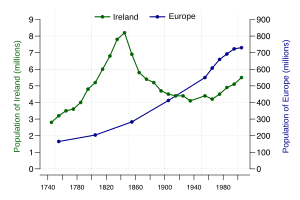Legacy of the Great Irish Famine facts for kids
The legacy of the Great Famine in Ireland (Irish: An Gorta Mór or An Drochshaol, meaning The Bad Life) was a huge event in Irish history. It happened between 1845 and 1852. During this time, the number of people in Ireland was cut in half.
The Great Famine (1845–1849) changed Ireland forever. It changed how many people lived there, its politics, and its culture. For Irish people, both in Ireland and those who moved away (the Irish diaspora), the famine became a strong memory. It helped inspire different nationalist groups. Today, historians see it as a major turning point. They often talk about "pre-Famine" times.
Remembering the Great Famine

Ireland remembered the 150th anniversary of the Great Famine in the 1990s. This was very different from the 100th anniversary in the 1940s. Back then, only a few events were held. One important project was a history book about the Famine. Also, the Irish Folklore Commission did a big survey in 1945.
In the 1940s, many Irish people were still leaving the country. This made some people feel uncomfortable about remembering the famine. Some felt a type of "Survivor guilt". They wondered how their own families had survived when others had not.
The 1990s saw a big change. Hundreds of events took place in Ireland and around the world where Irish people lived. The National Famine Commemoration Committee helped organize many of these events. At one big event in Millstreet, the British Prime Minister Tony Blair sent a message. He apologized for how past British governments had handled the crisis.
Many new studies about the famine were also written. These studies looked at how many people died or left Ireland. They also explored the long-term effects on society, land ownership, and Irish identity. In 2010, Britain did not send a diplomat to the National Famine Commemoration. However, 14 other countries did.
Songs of the Famine
The Famine is also remembered in songs, both old and new. Irish writer and songwriter Brendan Graham has written many songs and books about An Gorta Mór. His book, The Whitest Flower, came from songs he wrote about the famine. This book was even studied in some university courses.
"The Voice" was written by Brendan Graham. Eimear Quinn sang it when Ireland won the 1996 Eurovision Song Contest. The song's words talk about Ireland's difficult past. They clearly point to the famine times, saying, "I am The Voice of your hunger and pain." This song was also studied in music classes in the UK.
"The Fairhaired Boy" is another song by Brendan Graham. It tells the sad story of someone leaving Ireland during the famine. The song talks about the pain of saying goodbye. It mentions people going to California or Colorado. In Graham's book, a character sings this song to a dying boy on a quarantine island in Canada.
"Crucán na bPáiste" means 'the burial place of (unbaptised) children'. It is a sad song by a mother burying her child during the famine. Brendan Graham wrote this song for a character in his novel, The Brightest Day, The Darkest Night. Many artists have recorded it.
Another famine song by Graham is "Ochón an Ghorta Mhóir / Lament of the Great Hunger". The Irish Government asked him to write it. He chose the glasshouses at Dublin's National Botanic Gardens as his inspiration. These glasshouses were built when the famine was happening. Money meant for finding a cure for the potato blight was used to build them. Graham said the glasshouses held "a lament for a famished people."
"You Raise Me Up" is a very famous song. It was inspired by Brendan Graham's novel, The Whitest Flower. A Norwegian composer, Rolf Lovland, contacted Graham with a tune. This tune led Graham to write the words for "You Raise Me Up." Many famous artists have recorded this song. It has become one of the most successful songs ever.
Brendan Graham has also performed his famine songs and stories. He has done shows in Ireland and Australia. In Australia, he wrote a new song called "Orphan Girl." This song remembers the over 4,000 Irish teenage orphan girls. They were given free passage to Australia from workhouses between 1848 and 1850.
A well-known modern song about the famine is "The Fields of Athenry" by Pete St. John. It tells a fictional but realistic story. A man named Michael is sent to Botany Bay for stealing corn to feed his starving family. This song is popular with many groups. It shows the sadness, anger, and bitterness of those who suffered during the famine. The Dropkick Murphys, a punk rock band, also covered this song.

Luka Bloom's song 'Forgiveness' is about an Irish famine refugee in Canada. Despite his suffering, he chooses forgiveness over anger. Luka Bloom's brother, Christy Moore, also has a song called 'The City of Chicago'. It talks about the famine's effects and the many people who left Ireland.
The metal band Primordial has a song about the Famine called "The Coffin Ships." Sinéad O'Connor also has a song called "Famine." Her song highlights the political reasons behind the famine.
Ireland Helps Others
Ireland has become a leader in helping with famines around the world. In 1985, Bob Geldof, an Irish rock star who started Live Aid, said that Irish people gave more money per person than any other country. Irish charities like Goal, Concern, Trócaire, and Gorta help famine victims in Africa.
In 2000, Bono, the lead singer of the Irish band U2, helped campaign for debt relief for African nations. The experience of the Irish famine still influences many Irish people. It shapes how they feel about developing countries and people suffering from famine today.


